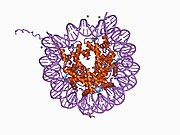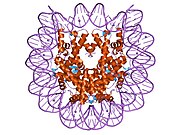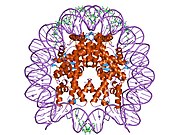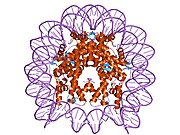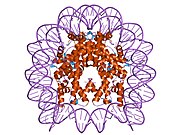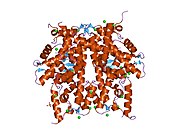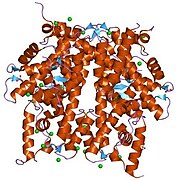HIST3H2A: Difference between revisions
Appearance
Content deleted Content added
m Robot: sorting stub (based on existing categorisation) |
m Open access bot: doi updated in citation with #oabot. |
||
| (31 intermediate revisions by 19 users not shown) | |||
| Line 1: | Line 1: | ||
{{Short description|Protein-coding gene in the species Homo sapiens}} |
|||
<!-- The PBB_Controls template provides controls for Protein Box Bot, please see Template:PBB_Controls for details. --> |
|||
{{Infobox_gene}} |
|||
{{PBB_Controls |
|||
'''Histone H2A type 3''' is a [[protein]] that in humans is encoded by the ''HIST3H2A'' [[gene]].<ref name="pmid12408966">{{cite journal |vauthors=Marzluff WF, Gongidi P, Woods KR, Jin J, Maltais LJ | title = The human and mouse replication-dependent histone genes | journal = Genomics | volume = 80 | issue = 5 | pages = 487–98 |date=Oct 2002 | pmid = 12408966 | doi =10.1016/S0888-7543(02)96850-3 }}</ref><ref name="entrez"/> |
|||
| update_page = yes |
|||
| require_manual_inspection = no |
|||
| update_protein_box = yes |
|||
| update_summary = yes |
|||
| update_citations = yes |
|||
}} |
|||
| ⚫ | Histones are basic [[nuclear protein]]s that are responsible for the [[nucleosome]] structure of the chromosomal fiber in [[eukaryotes]]. Nucleosomes consist of approximately 146 bp of [[DNA]] wrapped around a [[histone]] [[octamer]] composed of pairs of each of the four core histones (H2A, H2B, H3, and H4). The [[chromatin]] fiber is further compacted through the interaction of a linker histone, H1, with the DNA between the nucleosomes to form higher order chromatin structures. This gene is intronless and encodes a member of the histone H2A family. Transcripts from this gene contain a palindromic termination element.<ref name="entrez">{{cite web | title = Entrez Gene: HIST3H2A histone cluster 3, H2a| url = https://www.ncbi.nlm.nih.gov/sites/entrez?Db=gene&Cmd=ShowDetailView&TermToSearch=92815}}</ref> |
||
<!-- The GNF_Protein_box is automatically maintained by Protein Box Bot. See Template:PBB_Controls to Stop updates. --> |
|||
{{GNF_Protein_box |
|||
| image = PBB_Protein_HIST3H2A_image.jpg |
|||
| image_source = [[Protein_Data_Bank|PDB]] rendering based on 1aoi. |
|||
| PDB = {{PDB2|1aoi}}, {{PDB2|1eqz}}, {{PDB2|1hio}}, {{PDB2|1hq3}}, {{PDB2|1kx3}}, {{PDB2|1kx4}}, {{PDB2|1kx5}}, {{PDB2|1m18}}, {{PDB2|1m19}}, {{PDB2|1m1a}}, {{PDB2|1p34}}, {{PDB2|1p3a}}, {{PDB2|1p3b}}, {{PDB2|1p3f}}, {{PDB2|1p3g}}, {{PDB2|1p3i}}, {{PDB2|1p3k}}, {{PDB2|1p3l}}, {{PDB2|1p3m}}, {{PDB2|1p3o}}, {{PDB2|1p3p}}, {{PDB2|1s32}}, {{PDB2|1tzy}}, {{PDB2|1zbb}}, {{PDB2|1zla}}, {{PDB2|2aro}}, {{PDB2|2cv5}}, {{PDB2|2f8n}}, {{PDB2|2fj7}}, {{PDB2|2hio}}, {{PDB2|2nzd}} |
|||
| Name = Histone cluster 3, H2a |
|||
| HGNCid = 20507 |
|||
| Symbol = HIST3H2A |
|||
| AltSymbols =; MGC3165 |
|||
| OMIM = |
|||
| ECnumber = |
|||
| Homologene = 76385 |
|||
| MGIid = 2448458 |
|||
| GeneAtlas_image1 = PBB_GE_HIST3H2A_221582_at_tn.png |
|||
| Function = {{GNF_GO|id=GO:0003677 |text = DNA binding}} |
|||
| Component = {{GNF_GO|id=GO:0000786 |text = nucleosome}} {{GNF_GO|id=GO:0005634 |text = nucleus}} {{GNF_GO|id=GO:0005694 |text = chromosome}} |
|||
| Process = {{GNF_GO|id=GO:0006334 |text = nucleosome assembly}} {{GNF_GO|id=GO:0007001 |text = chromosome organization and biogenesis (sensu Eukaryota)}} |
|||
| Orthologs = {{GNF_Ortholog_box |
|||
| Hs_EntrezGene = 92815 |
|||
| Hs_Ensembl = ENSG00000181218 |
|||
| Hs_RefseqProtein = NP_254280 |
|||
| Hs_RefseqmRNA = NM_033445 |
|||
| Hs_GenLoc_db = |
|||
| Hs_GenLoc_chr = 1 |
|||
| Hs_GenLoc_start = 226711303 |
|||
| Hs_GenLoc_end = 226712197 |
|||
| Hs_Uniprot = Q7L7L0 |
|||
| Mm_EntrezGene = 319162 |
|||
| Mm_Ensembl = |
|||
| Mm_RefseqmRNA = NM_178218 |
|||
| Mm_RefseqProtein = NP_835736 |
|||
| Mm_GenLoc_db = |
|||
| Mm_GenLoc_chr = |
|||
| Mm_GenLoc_start = |
|||
| Mm_GenLoc_end = |
|||
| Mm_Uniprot = |
|||
}} |
|||
}} |
|||
'''Histone cluster 3, H2a''', also known as '''HIST3H2A''', is a human [[gene]].<ref name="entrez">{{cite web | title = Entrez Gene: HIST3H2A histone cluster 3, H2a| url = http://www.ncbi.nlm.nih.gov/sites/entrez?Db=gene&Cmd=ShowDetailView&TermToSearch=92815| accessdate = }}</ref> |
|||
<!-- The PBB_Summary template is automatically maintained by Protein Box Bot. See Template:PBB_Controls to Stop updates. --> |
|||
{{PBB_Summary |
|||
| section_title = |
|||
| ⚫ | |||
}} |
|||
==References== |
==References== |
||
{{reflist}} |
{{reflist}} |
||
==Further reading== |
==Further reading== |
||
{{refbegin | 2}} |
{{refbegin | 2}} |
||
*{{cite journal |vauthors=El Kharroubi A, Piras G, Zensen R, Martin MA |title=Transcriptional Activation of the Integrated Chromatin-Associated Human Immunodeficiency Virus Type 1 Promoter |journal=Mol. Cell. Biol. |volume=18 |issue= 5 |pages= 2535–44 |year= 1998 |pmid= 9566873 |doi= 10.1128/mcb.18.5.2535| pmc=110633 }} |
|||
{{PBB_Further_reading |
|||
*{{cite journal |vauthors=Deng L, de la Fuente C, Fu P, etal |title=Acetylation of HIV-1 Tat by CBP/P300 increases transcription of integrated HIV-1 genome and enhances binding to core histones |journal=Virology |volume=277 |issue= 2 |pages= 278–95 |year= 2001 |pmid= 11080476 |doi= 10.1006/viro.2000.0593 |doi-access= free }} |
|||
| citations = |
|||
*{{cite journal | |
*{{cite journal |vauthors=Deng L, Wang D, de la Fuente C, etal |title=Enhancement of the p300 HAT activity by HIV-1 Tat on chromatin DNA |journal=Virology |volume=289 |issue= 2 |pages= 312–26 |year= 2001 |pmid= 11689053 |doi= 10.1006/viro.2001.1129 |doi-access= free }} |
||
*{{cite journal | |
*{{cite journal |vauthors=Strausberg RL, Feingold EA, Grouse LH, etal |title=Generation and initial analysis of more than 15,000 full-length human and mouse cDNA sequences |journal=Proc. Natl. Acad. Sci. U.S.A. |volume=99 |issue= 26 |pages= 16899–903 |year= 2003 |pmid= 12477932 |doi= 10.1073/pnas.242603899 | pmc=139241 |bibcode=2002PNAS...9916899M |doi-access=free }} |
||
*{{cite journal | |
*{{cite journal |vauthors=Lusic M, Marcello A, Cereseto A, Giacca M |title=Regulation of HIV-1 gene expression by histone acetylation and factor recruitment at the LTR promoter |journal=EMBO J. |volume=22 |issue= 24 |pages= 6550–61 |year= 2004 |pmid= 14657027 |doi= 10.1093/emboj/cdg631 | pmc=291826 }} |
||
*{{cite journal | |
*{{cite journal |vauthors=Zhang Y, Griffin K, Mondal N, Parvin JD |title=Phosphorylation of histone H2A inhibits transcription on chromatin templates |journal=J. Biol. Chem. |volume=279 |issue= 21 |pages= 21866–72 |year= 2004 |pmid= 15010469 |doi= 10.1074/jbc.M400099200 |doi-access=free }} |
||
*{{cite journal |
*{{cite journal |vauthors=Aihara H, Nakagawa T, Yasui K, etal |title=Nucleosomal histone kinase-1 phosphorylates H2A Thr 119 during mitosis in the early Drosophila embryo |journal=Genes Dev. |volume=18 |issue= 8 |pages= 877–88 |year= 2004 |pmid= 15078818 |doi= 10.1101/gad.1184604 | pmc=395847 }} |
||
*{{cite journal |
*{{cite journal |vauthors=Wang H, Wang L, Erdjument-Bromage H, etal |title=Role of histone H2A ubiquitination in Polycomb silencing |journal=Nature |volume=431 |issue= 7010 |pages= 873–8 |year= 2004 |pmid= 15386022 |doi= 10.1038/nature02985 |bibcode=2004Natur.431..873W |s2cid=4344378 }} |
||
*{{cite journal |
*{{cite journal |vauthors=Gerhard DS, Wagner L, Feingold EA, etal |title=The Status, Quality, and Expansion of the NIH Full-Length cDNA Project: The Mammalian Gene Collection (MGC) |journal=Genome Res. |volume=14 |issue= 10B |pages= 2121–7 |year= 2004 |pmid= 15489334 |doi= 10.1101/gr.2596504 | pmc=528928 }} |
||
*{{cite journal | |
*{{cite journal |vauthors=Hagiwara T, Hidaka Y, Yamada M |title=Deimination of histone H2A and H4 at arginine 3 in HL-60 granulocytes |journal=Biochemistry |volume=44 |issue= 15 |pages= 5827–34 |year= 2005 |pmid= 15823041 |doi= 10.1021/bi047505c }} |
||
*{{cite journal |
*{{cite journal |vauthors=Rual JF, Venkatesan K, Hao T, etal |title=Towards a proteome-scale map of the human protein-protein interaction network |journal=Nature |volume=437 |issue= 7062 |pages= 1173–8 |year= 2005 |pmid= 16189514 |doi= 10.1038/nature04209 |bibcode=2005Natur.437.1173R |s2cid=4427026 }} |
||
*{{cite journal | |
*{{cite journal |vauthors=Cao R, Tsukada Y, Zhang Y |title=Role of Bmi-1 and Ring1A in H2A ubiquitylation and Hox gene silencing |journal=Mol. Cell |volume=20 |issue= 6 |pages= 845–54 |year= 2006 |pmid= 16359901 |doi= 10.1016/j.molcel.2005.12.002 |doi-access= free }} |
||
*{{cite journal |
*{{cite journal |vauthors=Bergink S, Salomons FA, Hoogstraten D, etal |title=DNA damage triggers nucleotide excision repair-dependent monoubiquitylation of histone H2A |journal=Genes Dev. |volume=20 |issue= 10 |pages= 1343–52 |year= 2006 |pmid= 16702407 |doi= 10.1101/gad.373706 | pmc=1472908 }} |
||
*{{cite journal |
*{{cite journal |vauthors=Gregory SG, Barlow KF, McLay KE, etal |title=The DNA sequence and biological annotation of human chromosome 1 |journal=Nature |volume=441 |issue= 7091 |pages= 315–21 |year= 2006 |pmid= 16710414 |doi= 10.1038/nature04727 |bibcode=2006Natur.441..315G |doi-access= free }} |
||
*{{cite journal | author=Cao R, Tsukada Y, Zhang Y |title=Role of Bmi-1 and Ring1A in H2A ubiquitylation and Hox gene silencing. |journal=Mol. Cell |volume=20 |issue= 6 |pages= 845-54 |year= 2006 |pmid= 16359901 |doi= 10.1016/j.molcel.2005.12.002 }} |
|||
*{{cite journal | author=Bergink S, Salomons FA, Hoogstraten D, ''et al.'' |title=DNA damage triggers nucleotide excision repair-dependent monoubiquitylation of histone H2A. |journal=Genes Dev. |volume=20 |issue= 10 |pages= 1343-52 |year= 2006 |pmid= 16702407 |doi= 10.1101/gad.373706 }} |
|||
*{{cite journal | author=Gregory SG, Barlow KF, McLay KE, ''et al.'' |title=The DNA sequence and biological annotation of human chromosome 1. |journal=Nature |volume=441 |issue= 7091 |pages= 315-21 |year= 2006 |pmid= 16710414 |doi= 10.1038/nature04727 }} |
|||
}} |
|||
{{refend}} |
{{refend}} |
||
{{PDB Gallery|geneid=92815}} |
|||
{{gene-1-stub}} |
{{gene-1-stub}} |
||
Latest revision as of 16:17, 3 December 2023
| H2AW | |||||||||||||||||||||||||||||||||||||||||||||||||||
|---|---|---|---|---|---|---|---|---|---|---|---|---|---|---|---|---|---|---|---|---|---|---|---|---|---|---|---|---|---|---|---|---|---|---|---|---|---|---|---|---|---|---|---|---|---|---|---|---|---|---|---|
 | |||||||||||||||||||||||||||||||||||||||||||||||||||
| Identifiers | |||||||||||||||||||||||||||||||||||||||||||||||||||
| Aliases | H2AW, histone cluster 3 H2A, HIST3H2A, H2A.W histone | ||||||||||||||||||||||||||||||||||||||||||||||||||
| External IDs | OMIM: 615015; MGI: 2448458; HomoloGene: 137357; GeneCards: H2AW; OMA:H2AW - orthologs | ||||||||||||||||||||||||||||||||||||||||||||||||||
| |||||||||||||||||||||||||||||||||||||||||||||||||||
| |||||||||||||||||||||||||||||||||||||||||||||||||||
| |||||||||||||||||||||||||||||||||||||||||||||||||||
| |||||||||||||||||||||||||||||||||||||||||||||||||||
| |||||||||||||||||||||||||||||||||||||||||||||||||||
| Wikidata | |||||||||||||||||||||||||||||||||||||||||||||||||||
| |||||||||||||||||||||||||||||||||||||||||||||||||||
Histone H2A type 3 is a protein that in humans is encoded by the HIST3H2A gene.[5][6]
Histones are basic nuclear proteins that are responsible for the nucleosome structure of the chromosomal fiber in eukaryotes. Nucleosomes consist of approximately 146 bp of DNA wrapped around a histone octamer composed of pairs of each of the four core histones (H2A, H2B, H3, and H4). The chromatin fiber is further compacted through the interaction of a linker histone, H1, with the DNA between the nucleosomes to form higher order chromatin structures. This gene is intronless and encodes a member of the histone H2A family. Transcripts from this gene contain a palindromic termination element.[6]
References
[edit]- ^ a b c ENSG00000284841 GRCh38: Ensembl release 89: ENSG00000181218, ENSG00000284841 – Ensembl, May 2017
- ^ a b c GRCm38: Ensembl release 89: ENSMUSG00000078851 – Ensembl, May 2017
- ^ "Human PubMed Reference:". National Center for Biotechnology Information, U.S. National Library of Medicine.
- ^ "Mouse PubMed Reference:". National Center for Biotechnology Information, U.S. National Library of Medicine.
- ^ Marzluff WF, Gongidi P, Woods KR, Jin J, Maltais LJ (Oct 2002). "The human and mouse replication-dependent histone genes". Genomics. 80 (5): 487–98. doi:10.1016/S0888-7543(02)96850-3. PMID 12408966.
- ^ a b "Entrez Gene: HIST3H2A histone cluster 3, H2a".
Further reading
[edit]- El Kharroubi A, Piras G, Zensen R, Martin MA (1998). "Transcriptional Activation of the Integrated Chromatin-Associated Human Immunodeficiency Virus Type 1 Promoter". Mol. Cell. Biol. 18 (5): 2535–44. doi:10.1128/mcb.18.5.2535. PMC 110633. PMID 9566873.
- Deng L, de la Fuente C, Fu P, et al. (2001). "Acetylation of HIV-1 Tat by CBP/P300 increases transcription of integrated HIV-1 genome and enhances binding to core histones". Virology. 277 (2): 278–95. doi:10.1006/viro.2000.0593. PMID 11080476.
- Deng L, Wang D, de la Fuente C, et al. (2001). "Enhancement of the p300 HAT activity by HIV-1 Tat on chromatin DNA". Virology. 289 (2): 312–26. doi:10.1006/viro.2001.1129. PMID 11689053.
- Strausberg RL, Feingold EA, Grouse LH, et al. (2003). "Generation and initial analysis of more than 15,000 full-length human and mouse cDNA sequences". Proc. Natl. Acad. Sci. U.S.A. 99 (26): 16899–903. Bibcode:2002PNAS...9916899M. doi:10.1073/pnas.242603899. PMC 139241. PMID 12477932.
- Lusic M, Marcello A, Cereseto A, Giacca M (2004). "Regulation of HIV-1 gene expression by histone acetylation and factor recruitment at the LTR promoter". EMBO J. 22 (24): 6550–61. doi:10.1093/emboj/cdg631. PMC 291826. PMID 14657027.
- Zhang Y, Griffin K, Mondal N, Parvin JD (2004). "Phosphorylation of histone H2A inhibits transcription on chromatin templates". J. Biol. Chem. 279 (21): 21866–72. doi:10.1074/jbc.M400099200. PMID 15010469.
- Aihara H, Nakagawa T, Yasui K, et al. (2004). "Nucleosomal histone kinase-1 phosphorylates H2A Thr 119 during mitosis in the early Drosophila embryo". Genes Dev. 18 (8): 877–88. doi:10.1101/gad.1184604. PMC 395847. PMID 15078818.
- Wang H, Wang L, Erdjument-Bromage H, et al. (2004). "Role of histone H2A ubiquitination in Polycomb silencing". Nature. 431 (7010): 873–8. Bibcode:2004Natur.431..873W. doi:10.1038/nature02985. PMID 15386022. S2CID 4344378.
- Gerhard DS, Wagner L, Feingold EA, et al. (2004). "The Status, Quality, and Expansion of the NIH Full-Length cDNA Project: The Mammalian Gene Collection (MGC)". Genome Res. 14 (10B): 2121–7. doi:10.1101/gr.2596504. PMC 528928. PMID 15489334.
- Hagiwara T, Hidaka Y, Yamada M (2005). "Deimination of histone H2A and H4 at arginine 3 in HL-60 granulocytes". Biochemistry. 44 (15): 5827–34. doi:10.1021/bi047505c. PMID 15823041.
- Rual JF, Venkatesan K, Hao T, et al. (2005). "Towards a proteome-scale map of the human protein-protein interaction network". Nature. 437 (7062): 1173–8. Bibcode:2005Natur.437.1173R. doi:10.1038/nature04209. PMID 16189514. S2CID 4427026.
- Cao R, Tsukada Y, Zhang Y (2006). "Role of Bmi-1 and Ring1A in H2A ubiquitylation and Hox gene silencing". Mol. Cell. 20 (6): 845–54. doi:10.1016/j.molcel.2005.12.002. PMID 16359901.
- Bergink S, Salomons FA, Hoogstraten D, et al. (2006). "DNA damage triggers nucleotide excision repair-dependent monoubiquitylation of histone H2A". Genes Dev. 20 (10): 1343–52. doi:10.1101/gad.373706. PMC 1472908. PMID 16702407.
- Gregory SG, Barlow KF, McLay KE, et al. (2006). "The DNA sequence and biological annotation of human chromosome 1". Nature. 441 (7091): 315–21. Bibcode:2006Natur.441..315G. doi:10.1038/nature04727. PMID 16710414.






